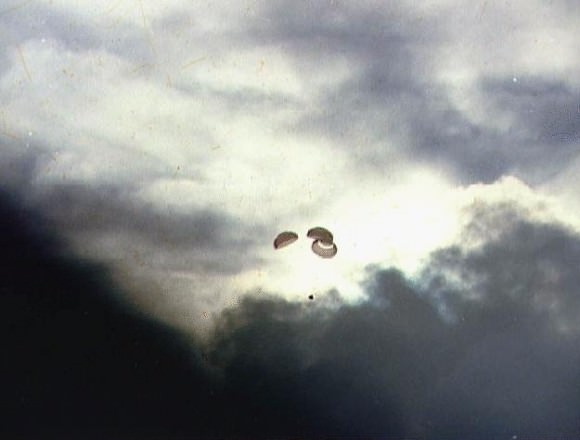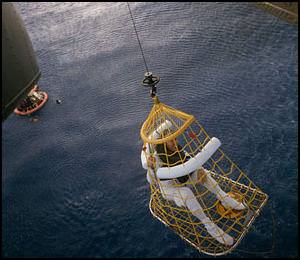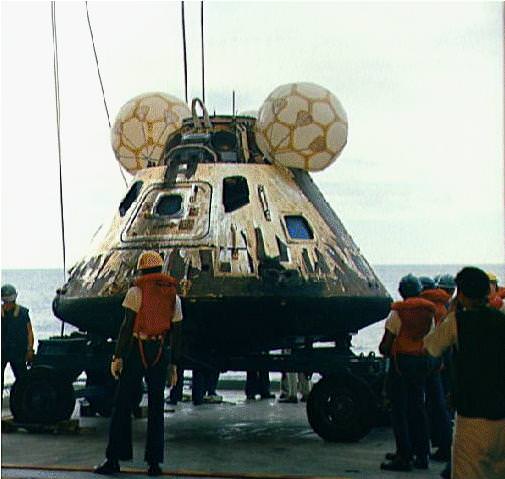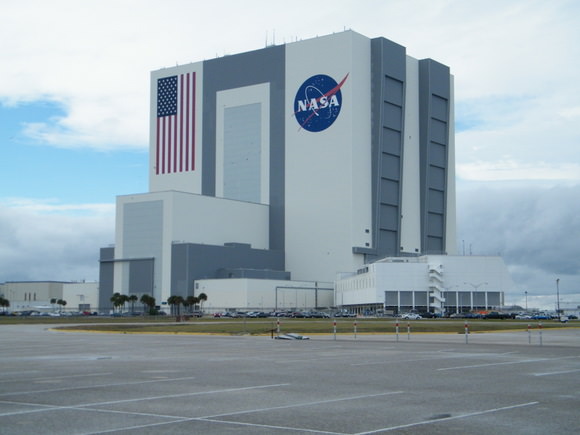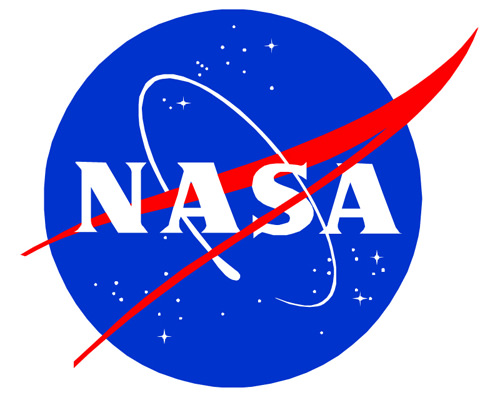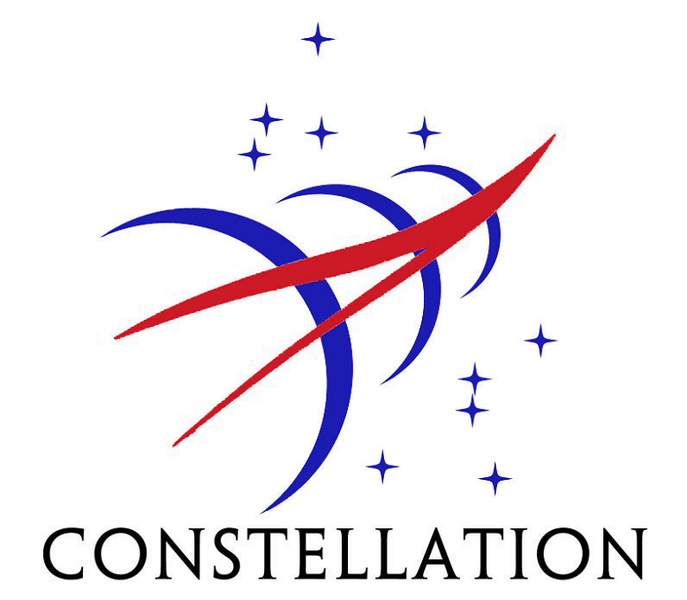Neil deGrasse Tyson — in his ever-ebullient fashion — answers a question about the new NASA budget. and what it means for the future. How much would you pay for the Universe?
A Look Inside the Space Shuttle “Garage”
This is home movies at their finest. Astronaut Mike Massimino takes us inside the garage of space shuttle Discovery — also known as the Orbiter Processing Facility (OPF)– for a behind the scenes look at the work that is done on the orbiters, as well as seeing some of the training for the astronauts on the upcoming STS-131 mission. This is part of a series of “behind the scenes for STS-131” videos that Massimino hosts, which you can find on the NASA TV You Tube channel. Mass brings humor and sense of wonder to these videos, and is great at doing public outreach for NASA.
Peggy Whitson: A Heroine of Science and Technology
[/caption]
This post is part of Ada Lovelace Day, which is a worldwide effort to get as many people as possible to blog about a heroine of science or technology. Ada was a mathematician who lived in the 1800’s who created the first computer program. Yep — you read correctly — a computer in the 1800’s. It was actually a device called an analytical engine, which was an important step in the history of computers. You can read more about Ada and Ada Lovelace Day here.
The person I chose to write about is a goddess of both science AND technology. She is a biochemist and an astronaut. She was the first science officer on board the International Space Station and later become the first female commander of the ISS. She helped get some of the initial science programs going on the on the space station, and as commander oversaw a period of one of the biggest expansions for the station, coordinating the additions of European and Japanese laboratory modules. Her name is ….
Dr. Peggy Whitson
Perhaps I have always been drawn to Whitson because she grew up in a rural, agricultural environment, as I did. But I have always found Whitson to be endearing because of her easygoing and friendly personality. But yet, she must be almost a “slave-driver” and perfectionist when it comes to her work. During her expeditions on the ISS, Whitson earned a reputation for high achievement, which prompted mission planners to assign the crew extra work every day. NASA called it “The Peggy Factor.”
“We account for the fact that Peggy is going to do things more efficiently, and that she likes to work some on her time off, and so she’ll accomplish more,” said NASA deputy station project manager Kirk Shireman.
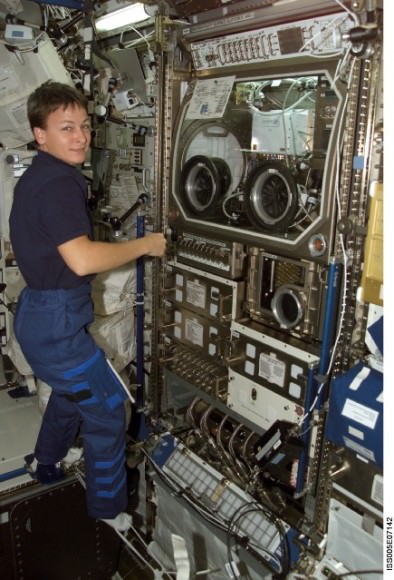
First some the details about Whitson: she graduated from Iowa Wesleyan College in 1981, and received her doctorate in biochemistry from Rice University in 1985. She worked as a Welch Postdoctoral Fellow before joining NASA in 1986.
From 1989 to 1993, Whitson was a research biochemist for NASA. During that time, she also served as an Adjunct Assistant Professor at the University of Texas and Rice University. In 1995, she became co-chair of a combined American and Russian working group, and a year later she was named an astronaut candidate.
Whitson flew her first space mission in 2002 as a flight engineer to the International Space Station as part of the Expedition 5 crew. While there, then NASA Administrator Sean O’Keefe gave her the title of first NASA Science Officer. Of course, she took some ribbing about being like “Spock,” the science officer on the original Star Trek, but she came to enjoy using the phrase “Live Long and Prosper.” During that mission she performed 21 experiments in human life science, microgravity sciences and commercial payloads.
During her second stint on the station, Expedition-16 in 2007-2008, she was named the commander.
I could go on about her accomplishments, but perhaps even better would be to let Whitson herself tell about her experiences in space. During her stays on the ISS, she wrote “letters home” to family and friends, answering questions and sharing details of her days in space.
Here’s what she had to say about doing science on the ISS:
I set up the first experiment inside the microgravity sciences glovebox this week. Tomorrow, I will do the powered checkouts of the glovebox and the next day start up the experiment. It is ssssoooo cool, getting to do science in space!!! This week we are also doing the urine collections for the renal stone investigation…and while I suspect this won’t be especially fun to collect the samples, I do think it’s one of the best experiments (I am biased, of course, since it is my experiment!).
In reading her letters, I found it interesting that she did amateur astronomy while on board the space station!:
One evening, I had dimmed the lights inside the module so that I could better watch the Earth/stars. I watched the sun set as we moved into the shadow of the Earth. I was pleasantly surprised a few min later to see a half-moon rise into view from behind the Earth. As the stars started popping into view, I was surprised again, as I saw a satellite pass by above us, looking so much like one of the other stars, but moving across the field of “constant” stars. I had never thought about the fact that I could, as one of those satellites, actually see another! And then I saw a second! Amazing.
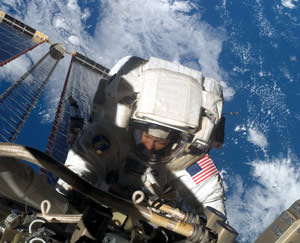
Whitson has conducted six spacewalks. Here’s how she described her first one:
My first look, as I poked my head out the hatch, was amazing! I previously compared the view of being in space to having lived in semidarkness for several years and having someone turn on the lights. Well, the view from my helmet, continuing the same analogy, would be like going outside on a sunny, clear day after having lived in semidarkness for years! If it gets better than this, I’m not sure my mind would be able to comprehend it!
And in this letter home, she waxes poetically about seeing Earth from space. She also talks about how people on Earth can watch for the ISS in the night sky, which is something that I love to do, and so it was interesting to read her perspective on that as well:
Although all the views of our planet are incredible and varied from our viewpoint up here on the Station, with the colors, textures, and lighting changing as we orbit…the most impressive view is the curve of the planet at the horizon. That curve is the special place where it is possible to see the layers of atmosphere extend beyond the surface to meet with the blackness of space beyond. Relative to the size of the Earth, it seems impossibly thin, less than a finger-width. The atmosphere carries all the shades of blue in that thin band, closest to the planet a glowing blue, like sunlit water over white sand, extending to the deepest blue-purple mixture that holds the blackness at bay.
As the night-side of the planet slips by beneath me, it carries on the fringes of darkness the colors of a sunset on the clouds below. The Station is still lit by the sun, despite the fact that we have already crossed the terminator between day and night below us. This is the timeframe when Station is most visible to folks on the ground, just before their dawn or after their dusk. A small bit of sunlight reflected off of our structure, illuminates us moving across their darkened sky. As the terminator approaches the horizon, the sun shows a blinding face that burns the atmosphere with molten reds and oranges before seemingly melting itself into the darkness, leaving a royal blue line that dissipates more slowly as the stars come out from hiding. Less than an hour passes before our path around the planet brings us back to the royal blue curve, signaling sunrise, as the process reverses itself. I am sure that after I return, I will again miss watching the curve of the Earth.
You can read more of Whitson’s letters home here.
Whitson’s ride home from space after Expedition 16 was more dramatic than expected. A malfunction made the Soyuz enter Earth’s atmosphere at a steeper angle than normal and the crew experienced “ballistic” descent at eight times the force of Earth-normal gravity. But, thankfully, everything turned out OK.
Whitson is currently chief of NASA’s astronaut office at Johnson Space Center.
Sources: Official NASA Astronaut bio, Orlando Sentinel
Obama to Unveil “Ambitous” Plan for NASA
President Obama will travel to Florida to unveil an “ambitious plan for NASA that sets the agency on a reinvigorated path of space exploration,” according to a press release from the White House. The President will host a conference on April 15, inviting space officials and leaders to discuss the new budget and plan for NASA and the future of U.S. leadership in human space flight. The location was not yet disclosed, but it likely will be at Kennedy Space Center.
Specifically, the conference will focus on the goals and strategies, the next steps, and the new technologies, new jobs, and new industries it will create, the White House said. Conference topics will include the implications of the new strategy for Florida, the nation, and our ultimate activities in space.
The proposed plan for NASA, which includes cutting the Constellation program to return to the Moon, has drawn extreme reactions — both praise and harsh criticism since first announced on Feb. 1, 2010. Most agreed, however, that the plan was short on details as to destinations and how we might get there.
After the Augustine Commission found that Constellation program was “fundamentally un-executable,” Obama’s new plan cancels the Ares rockets but add $6 billion for NASA over the next five years.
“This funding will help us achieve our boldest aspirations in space,” the White House said in the press release. “The President’s ambitious new strategy pushes the frontiers of innovation to set NASA on a more dynamic, flexible, and sustainable trajectory that can propel us on a new journey of innovation and discovery.”
But former astronaut Leroy Chiao, a member of the Augustine Commission said he was surprised Constellation was cut.
“I didn’t foresee the recent announcement of the cancellation of the NASA Orion crew exploration vehicle (CEV),” Chiao wrote in his blog,“the commercial option was for LEO access, not exploration. I expected that CEV, along with either a heavy lift vehicle, or a man-rated expendable launcher would serve as a complimentary system to commercial LEO efforts. Details of the US plans for the future of NASA human spaceflight remain to be revealed, but I remain cautiously optimistic. Sometimes it takes dramatic change, even temporary chaos, to affect the possibility of a quantum jump in improvement.”
There’s been much discussion about if this new “plan” means the end of human spaceflight as we know it. It might. But do we want to keep going with the status quo, or go in new directions? Hopefully the April 15 conference will provide the details everyone is craving. Change is hard, and certainly, not everyone will be satisfied.
Now, we just need to wait….
Apollo 13 Pictures
Here are some Apollo 13 pictures. You can make any of these pictures into your computer desktop background. Just click on an image to enlarge it, and then right-click and choose “Set as Desktop Background.
Here’s a photo of the Apollo 13 mission launching from Florida’s Cape Canaveral. It launched on April 11, 1970, just a few days before its accident in space, which has been turned into a popular movie.
This is an image of the Apollo 13 re-entry capsule returning to Earth, slowed by three large parachutes. Because of the accident, Apollo 13 kept its lunar lander attached to the Command Module for the entire trip around the Moon and back to Earth. They jettisoned it at the last minute just before re-entering the atmosphere.
Here’s a photo of the Apollo 13 capsule floating on the ocean after its landing. You can see command module pilot John L. Swigert Jr being lifted up by a helicopter.
And here’s a photo of Commander Jim Lovell being lifted up into the helicopter. He was the last of the three astronauts lifted up to safety after their capsule landed in the ocean.
This is an image of the Apollo 13 command module, which was normally used by the astronauts through the mission. Their command module had to be powered down to save power so they had to use the service module after the accident.
We’ve written many articles about Apollo 13 for Universe Today. Here’s an article about what really happened on Apollo 13, and here’s an article about the Apollo 13 launch.
If you’d like more information on Apollo 13, here’s a link to NASA’s Apollo 13 mission page, and here’s more information on the accident.
We’ve recorded an episode of Astronomy Cast about the NASA capsules. Listen here, Episode 124: Space Capsules.
Buzz Aldrin Says We Can Get to Mars by 2019
[/caption]
Buzz Aldrin is one of the few former astronauts who have spoken out in support of the new proposed budget/direction for NASA. But, now, Buzz wants to add a little “oomph” to the underlying goal of getting to Mars by providing one thing that many think is missing from President Obama’s proposed budget: heavy lift capability.
“I believe we can be well on our way to Mars by July 20, 2019 — which just happens to be the 50th anniversary of my Apollo 11 flight to the moon,” Buzz Aldrin wrote in an opinion piece on AOL.com. “The plan I’ve designed, called a unified space vision, contains ideas for the development of a deep-space craft that I call the Exploration Module, and development of a true heavy lift space booster evolved from the existing space shuttle.”
In last week’s Congressional hearings — which some journalists classified as a “grilling” instead of testimony, members of Congress expressed concern (sometimes bordering on outrage) when talking with NASA Administrator Charlie Bolden that under the proposed Obama plan, NASA will no longer be in the human spaceflight business, as space transportation services will be turned over to commercial firms.
Buzz says that with his plan, commercial carriers would fly astronauts and cargo up to the space station, but NASA would stay in the human spaceflight business by designing and building the Exploration Module, or XM.
The prototype of the spacecraft would be built in space, using excess modules and parts left over from constructing the space station. Buzz proposes continuing to fly the space shuttle for several additional flights to bring up the pieces. The XM would be docked to the station and outfitted by astronauts.
Then, attach a rocket engine is attached to the prototype and head to the Moon, just for a flyby.
To keep much of the current NASA workforce employed, Buzz proposes to use the shuttle until the replacement can be built, and to use shuttle derived part for the heavy lift XM. “Why should we abandon something before a replacement ship is available? Sure doesn’t make much sense to me,” he said.
“By building a deep-space craft,” Buzz writes, “NASA can use much of their engineering know-how and put a form to Charlie Bolden’s Mars mission dream. It allows the commercial folks their unfettered access to the station, as President Obama proposes. And it recommits America to leadership in space by aiming at Mars, using parts and equipment already paid for by the taxpayers.”
Buzz wants to know: What are we waiting for?
Tough Times Could Be Ahead for Kennedy Space Center
[/caption]
The cancellation of the Constellation program compounds an already bleak picture for the Kennedy Space Center and those who work there. 7,000 shuttle workers are expected to lose their jobs by the time the shuttle program comes to an end by late 2010 or early 2011. So far, NASA has not provided an estimate of how many government and contractor jobs will be lost as Constellation — the program that would have sent astronauts back to the Moon — will be slashed. But it could be a hard blow to KSC and communities surrounding the space center.
“This is a big deal and it is going to affect us,” said Kennedy Space Center Director Bob Cabana about the cancellation at a press conference earlier this week. Shuttle launch director Mike Leinbach talked about the “shock” and “uncertainty” that many at KSC are feeling.
But Cabana said that when it comes time to launch the space shuttles, everyone is focused. “The workforce here is the most professional and dedicated I’ve ever seen,” he said.
And since the STS-130 mission is scheduled to launch on Super Bowl Sunday, Leinbach took the opportunity to use a football analogy.
“I asked everybody to treat these last five missions like a professional team. We can be down in the fourth quarter; we can be many, many points behind,” Leinbach said, “but we’re going to play every down and we’re going until the final whistle blows.”
But while NASA officials try to paint the best picture possible, the workforce is definitely feeling apprehensive. Roughly 2,100 NASA civil servants at KSC are expected to remain employed, with assignments shifting toward technology research and development. But most of KSC’s 11,000 shuttle program workers are employed by contractors. Without the shuttle and without a subsequent government-based program for human spaceflight, the jobs will likely disappear.
“The mood at work has been sort of somber for a while now, but it seems a bit more anxious now,” said Jen Scheer, a shuttle technician for a NASA contractor. “Morale is definitely very low. We all love the shuttle program and will be very sad to see it come to an end.”
Scheer and her husband both work at KSC, and have been preparing for potential layoffs by returning to college for additional degrees and looking to other options for potential careers.

“The announcement Monday (about the cancellation of Constellation) really didn’t even faze us- we pretty much expected it,” Scheer said. “But a lot of the people we work with did not have the same reaction. They wanted to believe the shuttle would be extended, or they would be selected to go on to the next program. Many are very scared now.”
In addition to lost jobs, the housing market surrounding the Cape is in trouble. “Due to the depressed market here, not much has been selling for about the past two or three years,” Scheer said. “Property values dropped so sharply that many of us owe more on our homes than they are worth. So we really can’t leave. But we’ve seen it coming, and we know what we have to do.”
Cabana also said he and his team saw the likelihood that Constellation would be canceled, and have dug in to prepare for the future. He firmly believes human spaceflight will continue at KSC. “Launch Complex 39 is not going to go to waste. The geography of Florida makes it perfect for launching to orbit,” Cabana said. “That’s a unique facility out there with unique assets, and I think they will be available for commercial use also.”
Cabana said they’ve begun to organize to better support future exploration so that KSC is not program-centric, but support centric. “We’re working to define what our role is in commercial space,” he said
Even NASA Administrator Charlie Bolden, speaking at a press conference on Saturday, said that while he can empathize with workers at KSC, he admits he can’t feel what they are feeling. He compared the end of Constellation to a death in the family. “Every body needs to understand that, and give them time to grieve and time to recover,” he said earlier this week. “I have an incredible work force, they have been through this before. This is part of life at NASA, and we manage to recover and go on and do great things.”
But Scheer and her husband continue to plan ahead. As a staunch supporter of spaceflight, Scheer began the Space Tweep Society, an organization with mission to “promote enthusiasm for all things space and to unite those inside the space industry with those who are outside looking in.” To expand what the popular Twitter-based organization does for space education and awareness, Scheer is looking to create a non-profit organization and is planning to apply for education grants. “I think our only hope is going to be to get money from outside this area,” she said. “There are a lot of positive things I want to do to keep the dream of space exploration alive in our country even in the absence of a manned program.”
For more info about the Space Tweep Society
Read Jen Scheer’s article on the Open NASA website about the end of the shuttle program
Bolden: Heavy Lift Will Be International Effort and Not Until 2020-2030
[/caption]
NASA Administrator Charlie Bolden spoke with reporters Saturday at Kennedy Space Center on the eve of the launch of the STS-130 mission, answering questions that focused mainly on the new 2011 NASA budget and the cancellation of the Constellation program. The big question in many people’s minds is, with no Ares rockets, how will NASA do the “bold plans” for exploration and move beyond low Earth orbit? Bolden said that, NASA will build a heavy lift rocket, but likely not until sometime between 2020 and 2030, which is the same time frame – or later – that the Ares V was projected to be ready. Bolden said the biggest difference is that NASA will likely build a big rocket with international partners.
“I haven’t talked to anybody that doesn’t agree that the nation needs heavy lift capability,” said Bolden. “We need it for science, intelligence, for DOD, and NASA needs it for sending humans beyond orbit. How do we evolve there? We take the lessons learned from Constellation. If I’m able to negotiate with Congress appropriately we may actually be carving out some subsystems that are in Constellation because they are advanced technology, and they are things that we will need to develop a heavy lift system. So while we will phase out the Constellation program per se, I don’t want to throw out the baby with the bathwater. We want to try to capture technologies and capabilities that are resident in Constellation as we migrate towards a new system.”
Asked specifically about a timetable for heavy lift, Bolden said he ideally would like to see a rocket ready to go in the 2020 – 2030 time-frame, but that first NASA needs to decide what the destinations are. He said he thought Mars was the ultimate destination for humans, but that we would need to spend some time on the Moon first.
So, doesn’t this sound like Constellation – go to the Moon to prepare for Mars? Bolden admitted the cancellation of Constellation was for budgetary reasons. So, going forward, NASA will work (and split the costs) with other nations – as they are currently doing with the International Space Station — to explore beyond LEO.

“The President has instructed me that this is going to be in international effort,” Bolden said, “and that we are going expand our involvement with international partners. I’ll be meeting with three of my partners tonight before the launch, to talk about where we’re going from here. So it’s going to be different than the way we used to do it. We’re going to put international partners in the critical path, which means they may develop a system that we know how to do, but we don’t know how to do it as well.”
Bolden admitted he didn’t handle the rollout of the new budget and Constellation cancellation very well. “Why wasn’t the NASA workforce better prepared for this? I will take the heat, was because I didn’t listen to people to how we should roll this out. So we rolled out everything at once, and the workforce was not was not well prepared and I apologize. I was stupid, I admit that, I didn’t do it right.”
Bolden talked about the “game changing” technology of ion engines and using commercial companies as crew and cargo carriers to the ISS.
“Constellation was putting all our eggs in one basket,” he said. “Commercial allows us a redundant capability,” along with the ability to buy seats on the Soyuz rockets.
Bolden disagreed with those who have said the “flexible path sound like you’re going nowhere. I don’t agree. We will go as we develop the capability.”
He also “respectfully” disagrees with US Senator Richard Shelby’s (R-AL) opinion that this is the end of human spaceflight for NASA.
“We may get there more rapidly by opening up the venture with international partners,” Bolden said.
NASA Budget Details: Constellation Cancelled, But Where To Next?
We’ve lost the Moon. But have we gained the solar system while boosting commercial space ventures? “The President’s Budget cancels Constellation and replaces it with a bold new approach that invests in the building blocks of a more capable approach to space exploration,” states the Office of Management and Budget’s Fact Sheet on NASA’s 2011 budget. NASA will get additional $6 billion over the next five years tacked on to the current budget of just under $18 billion. The budget information released so far does not provide for a specific destination for humans in space. So, while some see this new direction as a course correction; others see it as an endgame. With an extension to the International Space Station to 2020, humans may well be stuck in low Earth orbit for at least another decade.
In this budget, the Ares rocket is history, and while no decision has been made on a heavy lift vehicle – necessary to launch humans beyond low-Earth orbit – NASA has been directed to continue research on such a vehicle that will “increase the capability of future exploration architectures with significantly lower operations costs than current systems – potentially taking us farther and faster into space.”
But in this proposed budget, which must be approved by Congress, NASA will provide funds for commercial space companies to build vehicles to ferry astronauts to and from the ISS. With the space shuttle program ending this year, NASA had agreed to pay Russia $50 million a seat. Commercial space companies could likely provide the seats for less money, but their vehicles are not yet human rated or tested.
It is true that the Constellation program was “over budget, behind schedule, and lacking in innovation due to a failure to invest in critical new technologies.” But $9 billion has already been spent on developing the Ares rockets and the Orion crew capsule, and $2.5 billion is in the budget proposal to close out Constellation.
Proponents of Obama’s budget proposal say moving towards using private commercial space companies will create more jobs per dollar because the government’s investment would be leveraged by millions of dollars in private investments.
“NASA investment in the commercial spaceflight industry is a win-win decision,” said Bret Alexander, president of the Commercial Spaceflight Federation, in a statement released last week. “Commercial crew will create thousands of high-tech jobs in the United States, especially in Florida, while reducing the spaceflight gap and preventing us from sending billions to Russia.’
NASA already has contracts with SpaceX and Orbital Sciences Corp. to bring cargo to the station, and . SpaceX is also developing vehicles to bring astronauts to orbit and back.
Already, some say they will fight this budget. “I, for one, intend to stand up and fight for NASA, and for the thousands of people who stand to lose their jobs,” said Senator Bill Nelson last week, as rumors were flying and details about the budget were leaking out.
With the US facing a federal deficit of $1.26 trillion in 2011, Obama federal budget proposal puts a three-year freeze on most non-defense discretionary spending after 2011, which the president believes will save $250 billion over the next 10 years. So, giving NASA the $6 billion over the next five year is a way to circumvent that freeze for NASA.
The budget proposal also includes:
$183 million to extend operations of the ISS past its previously planned retirement date of 2016. NASA will deploy new research facilities to conduct scientific research and test technologies in space. New capabilities could include a centrifuge to support research into human physiology, inflatable space habitats, and a program to continuously upgrade Space Station capabilities.
$600 million to complete the final five shuttle missions, allowing for a safe and orderly retirement of the Space Shuttle program even if its schedule slips into Fiscal Year 2011.
$1.2 billion for transformative research in exploration technology that will involve NASA, private industry, and academia, sparking spin-off technologies and potentially entire new industries.
$150 million to accelerate the development of new satellites for Earth Science priorities.
$170 million to develop and fly a replacement of the Orbiting Carbon Observatory, a mission to identify global carbon sources and sinks that was lost when its launch vehicle failed in 2009.
$500 million to contract with industry to provide astronaut transportation to the ISS, reducing the sole reliance on foreign crew transports and catalyzing new businesses and significant new jobs.
Increases Scientific Understanding of the Solar System and Universe
$3.2 billion for science research grants and dozens of missions and telescopes studying the planets and stars – including new missions such as the successor to the Hubble Space Telescope, missions to study the Moon, and two Mars exploration missions.
$14 million ($420 million over five years) for a mission to the Sun, flying through its outer atmosphere to better understand how it is heated and how it ejects the stream of charged particles known as the solar wind.
Increase funding to detect asteroids that could potentially pose a hazard to the Earth.
Increase annually the percentage of NASA higher education program student participants employed by NASA, aerospace contractors, universities, and other educational institutions.
For more details see this pdf from the OMB, or this OMB fact sheet.
President Can’t Cut Constellation Without Congressional Approval
With all the speculation currently making the rounds about Obama axing the Constellation program and ending the possibilities of humans returning to the Moon anytime soon, it was brought to our attention by a reader that under the 2010 Consolidated Appropriations Act, H.R. 3288, passed on September 17, 2009, Congress inserted a clause in the language of the FY2010 NASA funding bill that would prevent President Obama from terminating the Constellation program without Congressional approval. Senator Bill Nelson of Florida and Senator Richard Shelby from Alabama — two states that have a huge stake in NASA’s future — were the main sponsors of the clause in the Senate version. So, it doesn’t appear that Obama can just cut Constellation, not without a fight, anyway.
Also while we’re on the subject of NASA’s future, Administrator Charlie Bolden spoke in Israel yesterday, and journalist Avi Blizovsky from the online publication Hayadan shared with Universe Today some interesting comments Bolden made about NASA’s direction.
Bolden apparently confirmed that an agreement had been reached between NASA and its international partners to continue operations of the International Space Station until 2020. (Another Russian report said that NASA has suggested keeping the station operational until 2028).
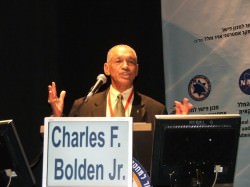
Bolden was in Israel at the Ilan Ramon International Space Conference to help announce that two new Israeli astronauts will be named.
Bolden said there will be dramatic changes to the human spaceflight program. “We are going to have to adapt to change, and the President’s decision is the beginning of the debate,” Bolden said. Without offering specific detail he added, “Based on what I know today is this is the best thing for the nation and for the family of space fairing nations.”
He said the current budgetary situation does not allow NASA to go to the Moon, but he emphasized the importance of international partnerships returning to the Moon and going to Mars. “Flying in space is expensive and risky and requires a broad set of capabilities that it is difficult for one nation to do it,” he said. “I think what President Obama wants me to do is work more closely with international partners.”
But he also stressed how commercial space companies will extremely important to the future of space exploration.
“As we phase the space shuttle out, we have got to find another way to get humans to space. What we’re going to focus on, … is facilitating the success of, I like to use the term ‘entrepreneurial interests’,” he said, saying that NASA has always used commercial companies to build and maintain the shuttle and other vehicles. “What’s going to change, I think, is that instead of NASA buying a vehicle and then taking over its primary operations, we will buy a service.”
So, back to speculating:
Also, remember the news that broke shortly after Obama and Bolden met at the White House in December: a White House insider reported that Obama is going cut Ares, but still ask Congress to fund a new heavy-lift launcher to take humans to the moon, asteroids, and the moons of Mars. The news in December said NASA would receive an additional $1 billion in 2011 (now reports are saying $1.8 billion) to get the new launcher on track and to bolster the agency’s fleet of robotic Earth-monitoring spacecraft.
So don’t count out returning to the Moon just yet.
Hat tip to UT reader Craigboy and the Daily Kos




